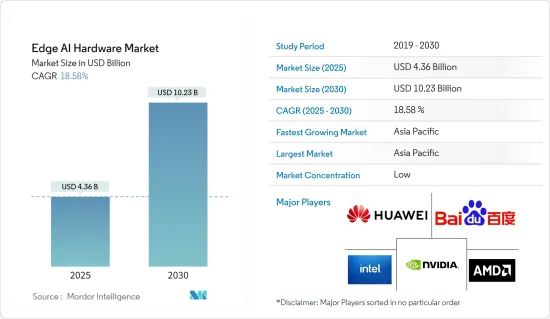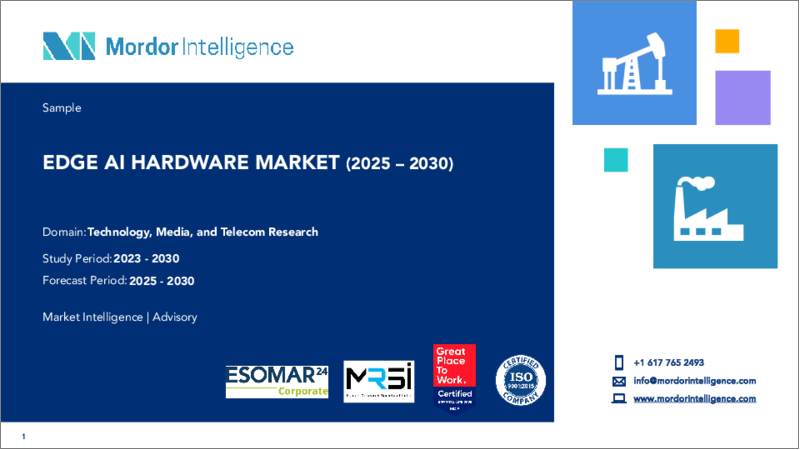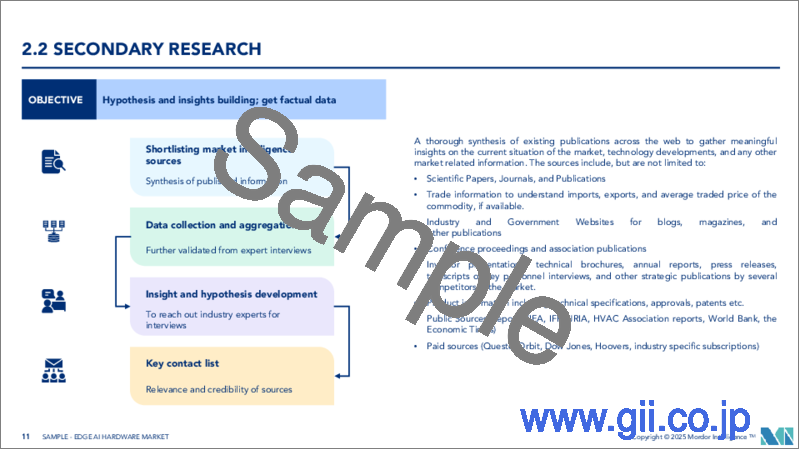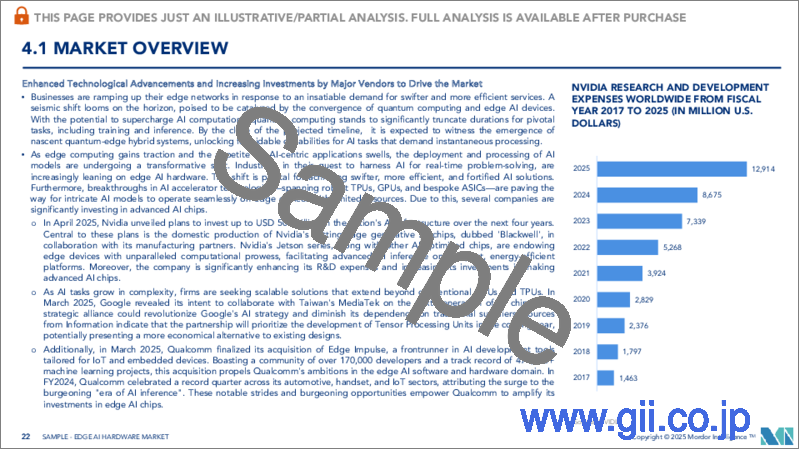|
|
市場調査レポート
商品コード
1642106
エッジAIハードウェア:市場シェア分析、産業動向・統計、成長予測(2025年~2030年)Edge AI Hardware - Market Share Analysis, Industry Trends & Statistics, Growth Forecasts (2025 - 2030) |
||||||
カスタマイズ可能
適宜更新あり
|
|||||||
| エッジAIハードウェア:市場シェア分析、産業動向・統計、成長予測(2025年~2030年) |
|
出版日: 2025年01月05日
発行: Mordor Intelligence
ページ情報: 英文 162 Pages
納期: 2~3営業日
|
全表示
- 概要
- 目次
エッジAIハードウェアの市場規模は、2025年に43億6,000万米ドルと推定され、予測期間中(2025-2030年)のCAGRは18.58%で、2030年には102億3,000万米ドルに達すると予測されます。

主なハイライト
- 仮想現実(VR)環境における臨場感の追求に後押しされ、エッジAIハードウェアの需要が大幅に急増しています。VR環境では、真に没入感のある体験を実現するために超低遅延が必要であり、わずかな処理遅延でもユーザーの臨場感を損なう可能性があります。エッジAIハードウェアは、デバイス上での処理を容易にし、デバイスとクラウド間のデータ転送を大幅に削減します。これにより、ゲーム、シミュレーション、トレーニングプログラムなどのVRアプリケーションに不可欠なリアルタイム性能が保証されます。
- エッジAIハードウェアは、主にリアルタイムかつ高性能な処理能力により、メディアおよびエンターテインメント業界を変革しています。この特性は、没入感のあるオーダーメイドの体験を生み出すために不可欠です。Netflix、YouTube、Amazon Prime Videoなどの大手メディア・ストリーミング・プラットフォームは、リアルタイム・コンテンツ配信を強化するため、エッジAIハードウェアの活用を加速させています。エンドユーザーに近いところでデータを処理することで、Edge AIは待ち時間を効果的に短縮し、スムーズな動画ストリーミングと視聴体験の向上を保証します。
- ストリーミングの領域を超えて、Edge AIハードウェアはビデオ編集や放送にも役立っています。解像度のアップスケール、フレームレートの向上、フィルターやエフェクトのリアルタイム適用などの機能を誇ります。例えば、AIアルゴリズムは、エッジデバイス上で標準的なビデオを直接4Kや8Kに昇格させることができ、クラウドに頼ることなく視聴品質を高めることができます。さらに、エッジデバイス上のAI駆動型ビデオ圧縮は、帯域幅の使用を最適化します。これは、データ負荷を低減しながらビデオの品質を維持することが不可欠なライブストリーミングにとって重要な要素です。
- しかし、エッジAIハードウェア市場は、主にハードウェアとソフトウェアの両方に対する多額の先行投資が原因で、課題に取り組んでいます。エッジAIハードウェアの基盤は、専用チップ、GPU(NvidiaのJetsonプラットフォームなど)、Tensor Processing Unit(TPU)、その他の高性能プロセッサで構成されています。これらのコンポーネントはリアルタイムのデータ処理とAI推論には欠かせないが、特に予算が厳しい中小企業や業界にとっては、そのコストの高さが導入の障壁となっています。
- COVID-19の流行後、通信機器の需要、デジタル化、スマートビルディングの台頭、ADAS搭載車、インダストリー4.0の原則といった動向がスマートエレクトロニクスと通信機器の成長に拍車をかけ、その後の市場拡大を後押ししています。
エッジ人工知能(AI)ハードウェア市場動向
ロボット・デバイス・セグメントが大きな市場シェアを占める見込み
- 人工知能(AI)とエッジコンピューティングは、ロボット工学の展望を急速に再構築し、よりスマートで自律的な機械の時代を到来させつつあります。エッジコンピューティングは膨大な量のデータを効率的に処理し、遅延や帯域幅の問題など、ロボット工学における従来の課題に取り組みます。同時に、AIはロボットが経験から学習し、情報に基づいた意思決定を行うことを可能にし、インテリジェントで適応性の高いマシンを実現します。この記事では、これらの技術がロボット工学とオートメーションの未来に与える影響について考察します。
- エッジAIは、ロボットがその場で環境データを処理することでリアルタイムの意思決定を行い、周囲の環境に迅速に適応することを可能にします。AIによるこのエッジ処理は、機械学習と推論アルゴリズムの両方を利用します。自律走行車や製造業など、環境の変化にタイムリーに反応することが重要な分野では、このような応答性が不可欠です。
- さらに、エッジAIはロボットの判断精度を高める。エッジデバイスにAIアルゴリズムを導入することで、ロボットは意思決定の精度を高めることができます。このような精度の向上は、ヘルスケアのような利害関係の大きい業界では最も重要です。
- さらに、エッジAIはプライバシーとセキュリティを強化し、ロボット工学を強化します。データをエッジ・デバイスに保存することで、機密情報が集中データセンターやクラウドに送られる途中で傍受されるリスクは減少します。この保護は、ヘルスケアや金融のように個人データを扱う分野では不可欠です。データがエッジで処理されることで、機密情報の転送は大幅に削減されます。そしてクラウドは、この処理されたデータの保管場所として、また接続されたデバイスのコントロールセンターとして機能します。このシフトにより、ソフトウェアとロボット工学のギャップを埋めるエッジAIハードウェアの需要が急増しています。
- 2024年4月、クアルコムはIoTとロボティクス向けに調整したEdge AI RB3 Gen 2チップを発表し、「Micro-Power」Wi-Fi SoCを添付しました。これらの開発キットは、同社のAI加速チップの展開を加速させることを目的としており、ロボット工学やIoTだけでなく、組み込みアプリケーションもターゲットとし、最大88%の消費電力削減の可能性を誇っています。エッジAIに大きく傾倒したこうした投資が、ロボット分野の市場成長を牽引しています。
大きな成長を遂げるアジア太平洋地域
- アジア太平洋地域は、コンシューマーエレクトロニクス市場で圧倒的な存在感を示しています。インド、中国、韓国を含む主要国は、政府のイニシアティブと主要業界プレイヤーの存在を通じて、現地生産を強化しています。このような動きは、家電製品の需要を増幅させると思われます。市場の拡大は、スマートフォン、IoTデバイス、組み込みシステムを含むエッジデバイスへのAIアルゴリズムの直接統合によってさらに促進されます。さらに、同地域では投資が増加しており、こうした市場技術に対する意欲は大幅な成長を遂げる構えです。
- 中国情報通信技術研究院(CAICT)によると、2023年の中国の携帯電話出荷台数は2億8,900万台に達し、前年比6.5%増となった。5G携帯電話の出荷台数は2億4,000万台で、年率11.9%増となり、中国の携帯電話総出荷台数の82.8%を占めました。CAICTのデータでは、国内ブランドの携帯電話の新機種が前年比5.5%増の406機種イントロダクションされたことも明らかになった。2023年12月の携帯電話出荷台数は前年比1.5%増の約2,828万台となった。これらの重要な開発は、市場の成長にプラスの影響を与える態勢を整えています。
- さらに、インベスト・インディアによると、インドのエレクトロニクス市場は現在1,550億米ドルと評価されており、国内生産がその65%を占めています。エレクトロニクス製品の採用が加速している背景には、技術的な変遷があり、特に5Gネットワークやモノのインターネット(IoT)の展開が挙げられます。デジタル・インド」や「スマート・シティ」プロジェクトのような取り組みが、電子機器市場におけるIoTの需要を高め、電子製品の新時代の幕開けを告げています。過去6年間で、インドは世界第2位の携帯電話メーカーに浮上しただけでなく、電子機器の国内生産も2倍以上に増加しました。
- アジア太平洋地域は、歴史的に製造業の大国であったが、モノのインターネット(IoT)の導入が進んでいます。Telenor IoTの報告によると、APACでは、韓国、日本、オーストラリア、中国などのIoT先進国と、インド、パキスタン、バングラデシュ、インドネシア、タイなどの新興国との相乗効果により、IoTデバイスの数が最近の145億台から2030年までに389億台に増加すると予測されています。このようにIoTの急増が予想される中、エッジAIハードウェアの需要も並行して大幅に増加する見込みです。
- さらに、同地域の複数の産業でロボットの導入が進んでいることも、市場機会を促進すると予想されます。IFRによると、2023年には、アジアが産業用ロボット導入の支配的勢力に浮上し、新規導入全体の70%を占める。特に中国が突出しており、世界全体の51%に相当する175万5,132台のロボットが稼働しています。
エッジ人工知能(AI)ハードウェア産業の概要
エッジAIハードウェア市場は、主要ベンダーが大きなシェアを占めており、さまざまな地域市場で足場を固めようと激しい競争を繰り広げています。このため、ベンダーは市場でのプレゼンスと技術力を獲得するために、いくつかの提携やパートナーシップを結んでいます。同市場の主要企業には、Intel Corporation、Huawei Technologies、Nvidia Corporation、Advanced Micro Devices Inc.、Baidu Inc.などがいます。
ベンダー間の競争戦略は、イノベーションによって市場参入の足掛かりを得ることであり、主要ベンダーの研究開発投資能力は高い方であるため、市場競争は激化しています。
流通チャネルへのアクセス、既存の取引関係、より優れたサプライチェーンの知識、さらに自社所有のプラットフォームは、既存大手ハイテク企業に新規参入企業に対する市場優位性を与えています。全体として、調査対象市場における競争企業間の敵対関係は中程度であり、予測期間中も変わらないと予想されます。
その他の特典:
- エクセル形式の市場予測(ME)シート
- 3ヶ月間のアナリストサポート
目次
第1章 イントロダクション
- 調査の前提条件と市場定義
- 調査範囲
第2章 調査手法
第3章 エグゼクティブサマリー
第4章 市場洞察
- 市場概要
- 業界の魅力度-ポーターのファイブフォース分析
- 新規参入業者の脅威
- 買い手/消費者の交渉力
- 供給企業の交渉力
- 代替品の脅威
- 競争企業間の敵対関係の強さ
- 市場に与えるマクロ経済要因の評価
- 産業バリューチェーン分析
第5章 市場力学
- 市場促進要因
- バーチャルリアリティ環境におけるよりリアルな体験の創出の高まり
- スポーツ業界におけるコンピュータビジョンの利用の増加
- メディア・エンターテイメント用途でのエッジAIハードウェアの採用拡大が成長を後押し
- 市場抑制要因
- エッジAIハードウェアとソフトウェアに多額の先行投資が必要
第6章 市場セグメンテーション
- プロセッサー別
- CPU
- GPU
- FPGA
- ASIC
- デバイス別
- スマートフォン
- カメラ
- ロボット
- ウェアラブル
- スマートスピーカー
- その他デバイス
- エンドユーザー産業別
- 政府機関
- 不動産
- 家電
- 自動車
- 運輸
- ヘルスケア
- 製造業
- その他
- 地域別
- 北米
- 欧州
- アジア
- オーストラリア・ニュージーランド
- ラテンアメリカ
- 中東・アフリカ
第7章 競合情勢
- 企業プロファイル
- Intel Corporation
- Huawei Technologies Co. Ltd
- Nvidia Corporation
- Advanced Micro Devices Inc.
- Baidu Inc.
- Google LLC(Alphabet Inc.)
- Qualcomm Incorporated
- Samsung Electronics Co., Ltd.
- Apple Inc.
- Amazon.com Inc.
- Alibaba Cloud(Alibaba Group Holding Limited)
- Continental AG
- Denso Corporation
- Robert Bosch GmbH
- Kalray
- MediaTek Inc.
- Imagination Technologies
第8章 投資分析
第9章 市場の将来
The Edge AI Hardware Market size is estimated at USD 4.36 billion in 2025, and is expected to reach USD 10.23 billion by 2030, at a CAGR of 18.58% during the forecast period (2025-2030).

Key Highlights
- Driven by the quest for heightened realism in virtual reality (VR) environments, the demand for Edge AI hardware is witnessing a significant surge. VR environments necessitate ultra-low latency for a truly immersive experience; even a minor processing delay can disrupt the user's sense of presence. Edge AI hardware facilitates on-device processing, significantly reducing the data transfer between the device and the cloud. This ensures the real-time performance crucial for VR applications, including gaming, simulations, and training programs.
- Edge AI hardware is transforming the media and entertainment industry, primarily due to its capability for real-time, high-performance processing. This attribute is essential for creating immersive and tailored experiences. Leading media streaming platforms, such as Netflix, YouTube, and Amazon Prime Video, are increasingly leveraging Edge AI hardware to enhance real-time content delivery. By processing data closer to the end-users, Edge AI effectively reduces latency, guaranteeing smooth video streaming and an enhanced viewing experience.
- Beyond the realm of streaming, Edge AI hardware is instrumental in video editing and broadcasting. It boasts capabilities like upscaling resolutions, enhancing frame rates, and applying filters or effects in real-time. For example, AI algorithms can elevate a standard video directly to 4K or even 8K on edge devices, boosting viewing quality without relying on the cloud. Furthermore, AI-driven video compression on edge devices optimizes bandwidth usage, a critical factor for live streaming where it's essential to maintain video quality while reducing data loads.
- However, the Edge AI hardware market grapples with challenges, primarily due to the hefty upfront investments in both hardware and software. The foundation of Edge AI hardware comprises specialized chips, GPUs (such as Nvidia's Jetson platform), Tensor Processing Units (TPUs), and other high-performance processors. While these components are vital for real-time data processing and AI inference, their high costs pose a barrier to adoption, particularly for smaller enterprises and industries with tighter budgets.
- Post the COVID-19 pandemic, trends like the demand for communication devices, digitalization, the rise of smart buildings, ADAS-equipped vehicles, and the principles of Industry 4.0 have spurred the growth of smart electronics and communication devices, subsequently driving the market expansion.
Edge Artificial Intelligence (AI) Hardware Market Trends
Robots Device Segment is Expected to Hold Significant Market Share
- Artificial intelligence (AI) and edge computing are rapidly reshaping the landscape of robotics, ushering in an era of smarter and more autonomous machines. Edge computing efficiently processes vast data volumes, tackling traditional challenges in robotics, such as latency and bandwidth issues. Concurrently, AI equips robots to learn from their experiences and make informed decisions, leading to machines that are both intelligent and adaptable. This article explores the profound influence of these technologies on the future of robotics and automation.
- Edge-AI enables robots to make real-time decisions by processing environmental data on-site, allowing for swift adaptation to their surroundings. This edge processing, powered by AI, utilizes both machine learning and inference algorithms. Such responsiveness is vital in sectors like autonomous vehicles and manufacturing, where timely reactions to environmental changes are crucial.
- Moreover, edge AI boosts the accuracy of robotic decisions. By deploying AI algorithms on edge devices, robots enhance their decision-making precision. This heightened accuracy is paramount in industries like healthcare, where the stakes are high.
- Additionally, Edge-AI fortifies robotics with enhanced privacy and security. By storing data on edge devices, the risk of sensitive information being intercepted en route to centralized data centers or the cloud diminishes. This protection is essential for sectors like healthcare and finance, which handle personal data. With data processed on the edge, the transfer of sensitive information is significantly reduced. The cloud then acts as both a repository for this processed data and a control center for connected devices. This shift has led to a surge in demand for edge AI hardware, bridging the gap between software and robotics.
- In April 2024, Qualcomm launched its Edge AI RB3 Gen 2 Chip tailored for IoT and robotics, accompanied by a "Micro-Power" Wi-Fi SoC. These development kits aim to expedite the company's AI-accelerating chip's deployment, targeting not just robotics and IoT but also embedded applications and boasting a potential power draw reduction of up to 88%. Such investments, heavily leaning on Edge AI, are driving the robotics segment's growth in the market.
Asia Pacific to Register Major Growth
- The Asia Pacific region stands out as a dominant player in the consumer electronics market. Major countries, including India, China, and Korea, are ramping up local production through government initiatives and the presence of key industry players. This push is set to amplify the demand for consumer electronics. The market's expansion is further fueled by the direct integration of AI algorithms into edge devices, encompassing smartphones, IoT devices, and embedded systems. Additionally, with rising investments in the region, the appetite for these market technologies is poised for substantial growth.
- According to the China Academy of Information and Communications Technology (CAICT), China's mobile phone shipments in 2023 reached 289 million units, marking a 6.5% increase from the previous year. Shipments of 5G phones hit 240 million units, an 11.9% annual rise, making up 82.8% of the country's total mobile phone shipments. CAICT data also highlighted the introduction of 406 new domestic-brand phone models, a 5.5% increase from the prior year. December 2023 saw mobile phone shipments touch approximately 28.28 million units, reflecting a 1.5% year-on-year growth. These significant developments are poised to positively influence the market's growth.
- Moreover, according to Invest India, the electronics market in India is currently valued at USD 155 billion, with domestic production constituting 65% of this value. The accelerated adoption of electronic products is being driven by technological transitions, notably the rollout of 5G networks and the Internet of Things (IoT). Initiatives like 'Digital India' and 'Smart City' projects have heightened the demand for IoT in the electronics devices market, signaling the dawn of a new era for electronic products. Over the past six years, India has not only emerged as the world's second-largest mobile manufacturer but has also seen its domestic production of electronics more than double.
- The Asia Pacific region, historically a manufacturing powerhouse, is increasingly embracing the Internet of Things (IoT). Telenor IoT reports that in APAC, the synergy between established IoT frontrunners like South Korea, Japan, Australia, and China and emerging players such as India, Pakistan, Bangladesh, Indonesia, and Thailand is propelling the number of IoT devices from a recent tally of 14.5 billion to a projected 38.9 billion by 2030. With this anticipated surge in IoT, there's a parallel expectation for a significant uptick in demand for Edge AI hardware.
- Furthermore, the growing adoption of robots across multiple industries in the region is also expected to drive market opportunities. According to IFR, in 2023, Asia emerged as the dominant force in industrial robot adoption, representing 70% of all new installations. Notably, China stands out, contributing a significant 51% to the global tally, boasting 1,755,132 operational robots across its factories.
Edge Artificial Intelligence (AI) Hardware Industry Overview
The Edge AI Hardware market is dominated by major vendors that cover a significant share of the market studied, and they are intensely competing to gain a foothold in different regional markets. Owing to this, vendors are involved in several partnerships and alliances to gain market presence and technological capabilities. Some of the major players in the market are Intel Corporation, Huawei Technologies Co. Ltd, Nvidia Corporation, Advanced Micro Devices Inc., and Baidu Inc., among others.
The competitive strategy among the vendors is to gain a foothold in the market studied with innovation, and the capability of investing in R&D by major vendors is on the higher side, thus, intensifying the competition in the market studied.
Access to the distribution channel, existing business relations, and better supply chain knowledge, along with the self-owned platform, give the established tech giants a market advantage over the new competitors. Overall, the degree of competitive rivalry in the market studied is moderately high and expected to remain the same over the forecast period.
Additional Benefits:
- The market estimate (ME) sheet in Excel format
- 3 months of analyst support
TABLE OF CONTENTS
1 INTRODUCTION
- 1.1 Study Assumptions and Market Definition
- 1.2 Scope of the Study
2 RESEARCH METHODOLOGY
3 EXECUTIVE SUMMARY
4 MARKET INSIGHTS
- 4.1 Market Overview
- 4.2 Industry Attractiveness - Porter's Five Forces Analysis
- 4.2.1 Threat of New Entrants
- 4.2.2 Bargaining Power of Buyers/Consumers
- 4.2.3 Bargaining Power of Suppliers
- 4.2.4 Threat of Substitute Products
- 4.2.5 Intensity of Competitive Rivalry
- 4.3 Assessment of Macroeconomic Factors on the Market
- 4.4 Industry Value Chain Analysis
5 MARKET DYNAMICS
- 5.1 Market Drivers
- 5.1.1 Rise in the Creation of More Realistic Experiences for Virtual Reality Environments
- 5.1.2 Increased Usage of Computer Vision in the Sports Industry
- 5.1.3 Growing Adoption of Edge AI Hardware in Media and Entertainment Applications Is Boosting Growth
- 5.2 Market Restraints
- 5.2.1 Significant Upfront Investment Required for Edge AI Hardware and Software
6 MARKET SEGMENTATION
- 6.1 By Processor
- 6.1.1 CPU
- 6.1.2 GPU
- 6.1.3 FPGA
- 6.1.4 ASICs
- 6.2 By Device
- 6.2.1 Smartphones
- 6.2.2 Cameras
- 6.2.3 Robots
- 6.2.4 Wearables
- 6.2.5 Smart Speaker
- 6.2.6 Other Devices
- 6.3 By End-User Industry
- 6.3.1 Government
- 6.3.2 Real Estate
- 6.3.3 Consumer Electronics
- 6.3.4 Automotive
- 6.3.5 Transportation
- 6.3.6 Healthcare
- 6.3.7 Manufacturing
- 6.3.8 Others
- 6.4 By Geography
- 6.4.1 North America
- 6.4.2 Europe
- 6.4.3 Asia
- 6.4.4 Australia and New Zealand
- 6.4.5 Latin America
- 6.4.6 Middle East and Africa
7 COMPETITIVE LANDSCAPE
- 7.1 Company Profiles
- 7.1.1 Intel Corporation
- 7.1.2 Huawei Technologies Co. Ltd
- 7.1.3 Nvidia Corporation
- 7.1.4 Advanced Micro Devices Inc.
- 7.1.5 Baidu Inc.
- 7.1.6 Google LLC (Alphabet Inc.)
- 7.1.7 Qualcomm Incorporated
- 7.1.8 Samsung Electronics Co., Ltd.
- 7.1.9 Apple Inc.
- 7.1.10 Amazon.com Inc.
- 7.1.11 Alibaba Cloud (Alibaba Group Holding Limited)
- 7.1.12 Continental AG
- 7.1.13 Denso Corporation
- 7.1.14 Robert Bosch GmbH
- 7.1.15 Kalray
- 7.1.16 MediaTek Inc.
- 7.1.17 Imagination Technologies





